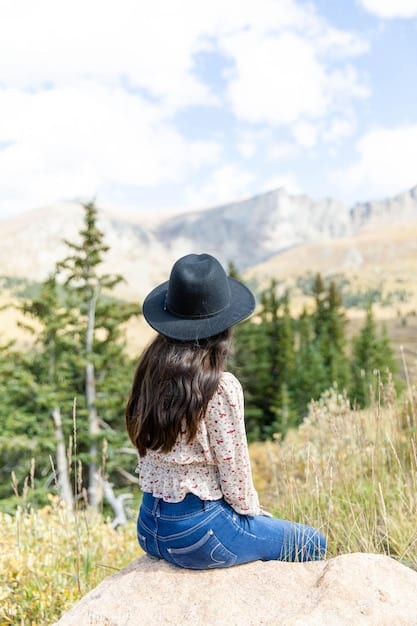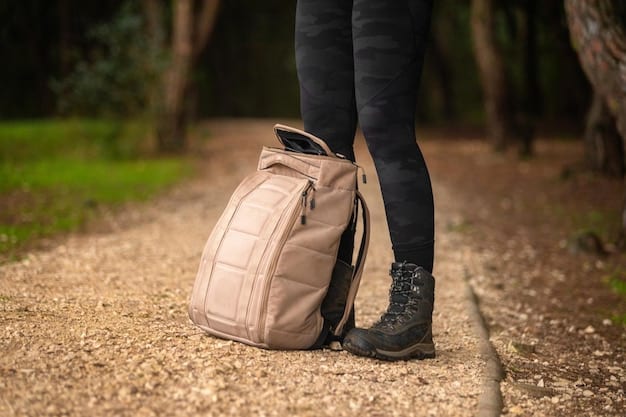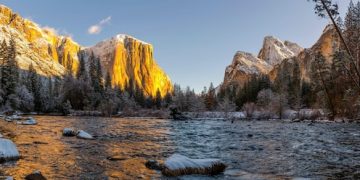Solo Traveler’s Guide to US: Safety & Destinations for 2025

Embarking on a solo journey across the United States in 2025 demands meticulous planning, prioritizing safety protocols, and identifying destinations that cater specifically to individual explorers seeking both adventure and tranquility, ensuring a rewarding and secure travel experience.
Embarking on a solo adventure can be one of life’s most transformative experiences, offering unparalleled freedom and a deep sense of self-discovery. As we look towards 2025, the United States, with its vast and diverse landscapes, presents an enticing canvas for the individual explorer. However, navigating a new destination alone, especially one as expansive as the US, requires careful consideration of safety and strategic planning. This comprehensive resource, The Solo Traveler’s Guide to the US: Safety Tips and Destination Ideas for 2025, aims to equip you with the knowledge and confidence needed to embark on your American journey safely and memorably, moving beyond common pitfalls to truly embrace the spirit of independent travel.
Navigating the Solo Journey: Essential Safety Protocols
For any solo traveler, safety is not merely a recommendation; it is the bedrock upon which a successful and enjoyable trip is built. When venturing across the diverse terrains of the United States, a proactive approach to personal security becomes paramount. Understanding the nuances of local environments, from bustling cityscapes to serene natural parks, is key to mitigating potential risks and ensuring peace of mind throughout your journey.
Before you even pack your bags, it’s wise to share your itinerary with trusted friends or family. This simple step provides a crucial safety net, as someone will always know your whereabouts and expected movements. Utilizing travel apps that allow for real-time location sharing can further enhance this safety measure, offering an additional layer of security in unfamiliar territories.
Digital Security and Communication
In today’s interconnected world, your digital footprint can be as important as your physical presence. Protecting your devices and personal information is a non-negotiable aspect of solo travel safety.
- Secure Your Devices: Always use strong, unique passwords or passcodes for your phone, laptop, and banking apps. Consider biometric locks (fingerprint, face ID) for an added layer of protection.
- Public Wi-Fi Beware: Avoid accessing sensitive information like banking or personal emails on unsecured public Wi-Fi networks. A virtual private network (VPN) is an indispensable tool for encrypting your internet traffic, even on seemingly safe networks.
- Communication Plan: Ensure your phone plan covers reliable data and calls throughout your travel areas. Consider purchasing a local SIM card or an e-SIM for consistent connectivity, especially in remote areas.
Personal Preparedness and Awareness
Beyond digital measures, cultivating personal awareness and preparedness is crucial. This involves not only understanding your surroundings but also being equipped to handle unforeseen circumstances.
- Situational Awareness: Always be aware of your immediate environment. Avoid distractions like constantly looking at your phone while walking, especially in crowded areas or at night. Trust your instincts; if a situation feels off, it likely is.
- Emergency Contacts and Documents: Keep a list of emergency contacts, your embassy or consulate details, and copies of important documents (passport, visa, insurance) both digitally and as physical printouts, stored separately from the originals.
- First Aid and Medication: Carry a small, well-stocked first-aid kit. If you have prescription medications, ensure you have enough for your trip, along with doctor’s notes if required, especially when crossing state lines.
Furthermore, understanding local emergency services numbers (911 in the US) and knowing how to describe your location accurately can save critical time in an emergency. Preparing for varied weather conditions and terrain is also part of physical safety, particularly if your journey involves outdoor activities or exploring diverse climates across the US.
Ultimately, a solo traveler’s safety in the US is a blend of technological vigilance, keen personal awareness, and thorough preparation. By incorporating these protocols, the potential for unexpected challenges can be significantly minimized, allowing for a more immersive and worry-free exploration of the country.
Strategic Planning for the Solo Explorer: Logistics and Budgeting
Solo travel, while offering immense freedom, also places the entire burden of logistics and financial management squarely on your shoulders. Strategic planning is not about stifling spontaneity, but rather about creating a robust framework that supports your journey, prevents unwelcome surprises, and maximizes your travel budget. For the solo explorer venturing into the United States in 2025, this means meticulously considering transportation, accommodation, and daily expenses.
One of the first logistical hurdles is transportation. The US is vast, and relying solely on public transport can be limiting, especially outside major metropolitan areas. Renting a car offers unparalleled flexibility for exploring national parks or scenic drives, but this comes with costs like rental fees, insurance, and fuel. Alternatively, long-distance buses (like Greyhound) or trains (Amtrak) can be cost-effective for inter-city travel, though they often trade speed for affordability. For cross-country journeys, domestic flights might be necessary, requiring booking well in advance for better rates.
Accommodation Choices and Cost-Effectiveness
Your choice of accommodation can significantly impact both your budget and your safety. Solo travelers have a myriad of options, each with its own advantages.
- Hostels: Ideal for budget-conscious travelers, hostels offer communal spaces, fostering connections with other travelers. Look for hostels with good safety ratings, private lockers, and female-only dorms if preferred.
- Budget Hotels/Motels: These provide more privacy than hostels and can be found across the country. Prioritize establishments with positive reviews regarding cleanliness and security.
- Vacation Rentals (e.g., Airbnb): Offering a “home away from home” feel, vacation rentals can be great for longer stays or those looking for kitchen facilities. Always check reviews, especially from other solo travelers, and ensure the host is responsive and verified.
Beyond the cost of the stay itself, consider location. Staying slightly outside the main tourist centers can often reduce accommodation expenses, but remember to factor in the cost and time of commuting to attractions. Proximity to public transport, if you’re not driving, becomes a key consideration.
Budget Management and Financial Security
Effective budgeting keeps your solo trip on track without financial stress. It’s not just about saving money; it’s about intelligent spending and financial safeguards.
- Daily Expense Tracking: Use a budgeting app or a simple spreadsheet to track your daily expenditure. Categorize spending on food, transport, activities, and accommodation to identify where your money is going.
- Contingency Fund: Always allocate a portion of your budget for emergencies. Unexpected medical needs, travel delays, or lost belongings can quickly drain your funds.
- Multiple Payment Methods: Don’t rely on a single credit card or source of cash. Carry a primary credit card, a backup, and some local currency for small purchases or emergencies. Inform your bank of your travel plans to avoid card freezes.
Planning meals can also significantly affect your daily budget. While dining out is part of the experience, balancing it with cooking a few meals (if your accommodation allows) or opting for grocery store picnics can lead to substantial savings. Researching local deals, free attractions, and city passes can also uncover hidden savings.
By investing time in strategic planning, solo travelers can approach their US adventure with confidence, knowing they have a clear understanding of their logistical options and financial parameters. This foresight empowers them to make informed decisions on the go, leading to a more fulfilling and less stressful travel experience.
Top Destinations for Solo Travelers in the US (2025)
Choosing the right destination is perhaps the most exciting part of planning any trip, and for solo travelers in the US, the options are as varied as the landscape itself. In 2025, certain cities and regions continue to stand out for their blend of safety, accessibility, and unique experiences that cater specifically to the independent explorer. The key is to find locations that offer a balance of vibrant culture, natural beauty, and ample opportunities for self-discovery without feeling isolated or overwhelmed.
Major cities often make excellent starting points for solo adventurers due to their well-developed public transportation, diverse dining options, and a plethora of activities. New York City, for instance, offers endless museums, theaters, and neighborhoods to explore, where one can easily blend into the crowd. Its extensive subway system makes navigation straightforward, and there are numerous solo-friendly dining options. Similarly, Chicago’s stunning architecture, world-class museums, and beautiful lakefront path provide ample opportunities for solitary exploration and appreciation.
Urban Escapes: Culture and Connectivity
Certain cities are particularly conducive to solo exploration, offering a mix of safety, walkability, and engaging activities.
- Seattle, Washington: Known for its coffee culture, vibrant arts scene, and proximity to natural beauty, Seattle is a very walkable city. Its emphasis on outdoor activities and independent businesses makes it easy to connect with local culture.
- Portland, Oregon: A haven for foodies and nature lovers, Portland boasts a laid-back vibe, excellent public transport, and a thriving independent scene. Its numerous parks, microbreweries, and unique shops cater well to individual exploration.
- Austin, Texas: (“Live Music Capital of the World”) boasts a lively yet welcoming atmosphere. Its food truck scene, extensive green spaces for outdoor activities, and friendly locals make it an easy city to navigate and enjoy solo.

Nature’s Embrace: Solo Adventures in the Wilderness
For those drawn to the tranquility and grandeur of nature, the US offers unparalleled opportunities for solo outdoor adventures. National parks, while requiring careful planning for safety, can be profoundly rewarding.
- Zion National Park, Utah: With well-marked trails and a shuttle system that makes it easy to navigate, Zion offers breathtaking landscapes for hikers of various skill levels. Its popularity means trails are generally not deserted, adding a layer of safety.
- Acadia National Park, Maine: This coastal gem provides a blend of rugged coastline, serene lakes, and forested mountains. Its manageable size and numerous carriage roads (perfect for cycling or walking) make it accessible for solo exploration.
- Sedona, Arizona: Renowned for its stunning red rock formations and spiritual vortexes, Sedona is a popular destination for hikers and those seeking a calming retreat. Its vibrant town center offers amenities and guided tours for solo visitors.
When venturing into natural areas, always inform someone of your plans, stick to marked trails, carry sufficient water and supplies, and be prepared for changing weather conditions. Many parks also offer ranger-led programs, which can be a great way to explore safely and learn more about the area while potentially meeting other travelers.
The beauty of solo travel in the US in 2025 lies in its limitless possibilities. Whether you seek the bustling energy of a major city or the serene solitude of the wilderness, there’s a destination perfectly suited to your aspirations for an independent journey. The key is to research thoroughly, align your chosen destination with your travel style, and always prioritize your well-being.
Budgeting Smart: Making Your Solo US Trip Affordable
Traveling solo in the United States, while offering immense freedom, can quickly accumulate costs if not managed prudently. A strategic approach to budgeting is essential for making your American adventure in 2025 not only memorable but also financially sustainable. It’s about finding the balance between enjoying unique experiences and making smart financial choices, ensuring your funds last the duration of your trip without compromising on safety or essential comforts.
The first step in smart budgeting is creating a detailed pre-trip financial plan. This involves estimating costs for major categories: flights, accommodation, transportation within destinations, food, activities, and an emergency fund. Researching average costs in your chosen destinations can provide a realistic baseline. For instance, New York City will inherently be more expensive than a small town in the Midwest, and adjusting your expectations accordingly is crucial.
Accommodation and Transportation Savings
These two categories often represent the largest share of a solo traveler’s budget and offer significant opportunities for savings.
- Hostel Savvy: Opt for hostels, as mentioned previously, but also look for those offering discounts for longer stays or non-refundable bookings if your plans are firm. Many hostels also include free breakfast, saving you on daily food costs.
- Off-Peak Travel: If your schedule allows, traveling during the shoulder season (spring or fall) or even the off-season can lead to substantial savings on flights and accommodation. Popular destinations are less crowded, and prices drop.
- Public Transport & Walking: In cities with good public transport networks, utilize subways, buses, or trams. This is often significantly cheaper than taxis or ride-shares. Embrace walking as much as possible; it’s free, healthy, and a great way to discover a city.
When considering inter-city travel, comparing the cost of flights versus long-distance buses or trains is vital. While buses are often the cheapest, they can be time-consuming. Look for overnight bus or train options to save on a night’s accommodation. For extended trips, consider if a multi-city pass on rail or bus makes financial sense.
Food and Activity Cost Management
Eating and experiencing local culture are vital parts of travel but can quickly inflate your budget if not managed carefully.
- Cook Your Meals: If staying in accommodations with kitchen facilities (hostels, Airbnb, some extended-stay hotels), buying groceries and cooking some of your meals can lead to enormous savings compared to dining out three times a day.
- Street Food and Local Markets: Explore local street food vendors and farmers’ markets for delicious, authentic, and often affordable meal options. Many US cities have thriving food truck scenes.
- Free Activities: Research free attractions in each destination. Many cities offer free walking tours (tip-based), public parks, free museum days/hours, or open-air markets that provide rich cultural experiences without the price tag.
- Discounts and Passes: Investigate city passes or attraction bundles if you plan to visit multiple paid attractions. Student discounts, if applicable, can also lead to significant savings.
Lastly, keep a firm grip on impulse purchases. Souvenirs can add up quickly. Focus on collecting experiences and memories rather than physical items. By implementing these smart budgeting strategies, solo travelers can extend their adventures across the US, ensuring that financial constraints do not limit their solo exploration in 2025.
Navigating Transportation: Wheels, Rails, and Wings
The vastness of the United States presents a unique challenge and opportunity for solo travelers when it comes to transportation. Unlike smaller, more interconnected countries, navigating the US requires a strategic approach, blending different modes of transport to suit distances, budgets, and the desire for flexibility. Your choice of transportation will significantly influence your itinerary, how much you see, and the overall pace of your solo adventure in 2025.
Long-distance travel between major cities often involves flying. Domestic flights can be surprisingly affordable if booked well in advance, especially on budget carriers like Southwest, Spirit, or Frontier. However, remember to factor in baggage fees, which can add up quickly for solo travelers who bring more than a carry-on. Flying saves time, making it ideal for those with limited vacation days or ambitious multi-city itineraries spanning different regions.
The Freedom of the Open Road: Car Rentals
For many solo travelers, especially those keen on exploring national parks, small towns, or scenic routes, renting a car offers unparalleled freedom. It allows for spontaneous detours and access to areas not served by public transport.
- Booking and Insurance: Book your rental car well in advance, especially during peak seasons. Carefully consider rental car insurance options; your personal insurance or credit card might offer some coverage, but it’s crucial to verify beforehand.
- Fuel Costs: Factor in fuel expenses, which can be a significant part of your budget, especially on long drives. Use apps like GasBuddy to find the cheapest gas prices along your route.
- Navigation: Always have a reliable GPS (either built-in, smartphone app, or dedicated device) and consider downloading offline maps in case of poor signal in remote areas.
Driving solo across vast stretches can be tiring, so plan for regular breaks and consider breaking up long journeys with overnight stops. Ensure your car is serviced and familiar with basic roadside emergency procedures. Remember to always lock your car, especially when leaving it unattended, and keep valuables out of sight.
Public Transport: Inter-City and Urban Navigation
While a car offers freedom, public transport is often the most economical and sustainable choice, particularly within cities.
- Buses (Greyhound, Megabus): Inter-city buses are generally the cheapest option for traveling between major US cities. They offer basic amenities and can be a good way to meet other travelers, though they can be slow and less comfortable for very long journeys.
- Trains (Amtrak): Amtrak offers a more comfortable, albeit usually more expensive, alternative to buses. It provides a unique way to see the country, with scenic routes and the ability to move around while traveling. Book sleepers for overnight journeys to save on accommodation costs.
- Urban Transit: Most major US cities have extensive public transport systems (subways, buses, light rail). Purchase multi-day passes if available, as they often offer better value than single tickets. Google Maps is excellent for navigating public transit routes.
Beyond these, ride-sharing apps (Uber, Lyft) are widely available in urban areas and offer a convenient door-to-door service, although their cost can add up. Taxis are also an option but typically more expensive. Understanding the nuances of each transportation mode and how they fit into your itinerary and budget will be a cornerstone of successful solo travel in the US.
Solo Dining and Social Connections
One of the quiet joys and occasional challenges of solo travel is dining alone. For some, it’s an opportunity for quiet reflection and people-watching; for others, it can feel a bit daunting. However, in the US, the culinary landscape is incredibly diverse, offering numerous solo-friendly options. Beyond dining, making social connections as a solo traveler can enrich your journey, though it requires a proactive approach and an open mind.
When it comes to dining, many restaurants, especially in larger cities, are accustomed to solo diners. Sitting at the bar is often an excellent strategy; it’s generally more social, allowing for casual conversation with the bartender or fellow patrons. Cafes, diners, and casual eateries are also perfect for a solo meal, often less formal and with a higher turnover of tables. Exploring food markets and food truck parks offers a vibrant, low-pressure way to sample various cuisines and often includes communal seating areas.
Embracing the Solo Dining Experience
Transform lingering uncertainties about solo dining into opportunities for deeper engagement with your surroundings.
- Journaling and Reading: Utilize meal times for personal reflection. Bring a journal to jot down thoughts or a book to read, turning dining into a productive and mindful activity.
- People-Watching: Observe the local culture and street life. This can be as entertaining and informative as any guided tour.
- Casual Conversations: Be open to polite conversation if someone engages you. A simple “hello” can sometimes lead to interesting exchanges with locals or other travelers.
Don’t dismiss fine dining if it’s within your budget. Some high-end restaurants are adept at making solo diners feel comfortable, and it can be a luxurious treat for yourself. Just make a reservation and mention you’ll be dining alone; they may seat you in a more appropriate area.
Forging Connections on the Road
Meeting new people as a solo traveler can enhance your experience, offering shared moments and diverse perspectives. It requires stepping out of your comfort zone, but the rewards are often great.
- Hostel Common Areas: Hostels are natural hubs for meeting other travelers. Engage in conversations in common rooms, kitchens, or during organized social events.
- Guided Tours and Classes: Joining walking tours, cooking classes, or day trips is an excellent way to meet like-minded individuals with shared interests. These structured activities provide a natural context for conversation.
- Local Meetup Groups: Use apps like Meetup.com to find local groups with interests aligned with yours, from hiking clubs to book discussions. This can be a great way to connect with locals.
- Volunteering: Consider short-term volunteering opportunities. Not only do you give back, but you also meet locals and other volunteers who share your values.
While being open to connections, always remember personal safety. Exercise discretion when sharing personal information, and meet new acquaintances in public places. Trust your instincts. Ultimately, solo travel is about finding your own rhythm, whether that means cherishing solitude or actively seeking out new friendships and shared experiences, making your US journey in 2025 truly your own.
Packing Smart and Staying Healthy on the Road
The art of packing for solo travel, particularly across the varied climates and activity options of the US, is a delicate balance of efficiency and preparedness. Every item you carry is an item you alone are responsible for. Beyond packing, maintaining your health and well-being on the road is paramount, ensuring you have the energy and resilience to fully enjoy your adventure in 2025.
The golden rule for packing is “less is more.” Aim for versatile clothing that can be mixed and matched and layered for different weather conditions. Merino wool, for example, is excellent for its temperature-regulating and odor-resistant properties, reducing the amount of clothing you need. Invest in good quality, comfortable walking shoes, as you will likely be doing a lot of exploring on foot. Consider quick-drying fabrics for laundry ease on the go.
Essentials for Your Solo Pack
Beyond clothing, several items are crucial for solo travel effectiveness and safety.
- First-Aid Kit: A compact kit with essentials like pain relievers, bandages, antiseptic wipes, allergy medication, and any personal prescriptions is non-negotiable.
- Medication & Prescriptions: Carry enough of any prescription medication for your entire trip, along with a copy of your prescription and a doctor’s note, especially for controlled substances.
- Reusable Water Bottle: Staying hydrated is crucial, and a reusable bottle helps reduce plastic waste and saves money on bottled water. Many public places have accessible water fountains.
- Portable Charger: Your phone will be your map, camera, and communication device. A portable power bank ensures you’re never without power, especially in remote areas.
Consider the type of luggage that best suits your travel style. A comfortable backpack is ideal for those constantly on the move, while a wheeled suitcase might be better for urban trips with less frequent changes of accommodation. Always pack a small daypack for daily excursions, allowing you to carry essentials without lugging your main luggage.

Prioritizing Health and Well-being
Maintaining physical and mental health while traveling solo requires intentional effort.
- Balanced Diet: While trying local cuisine is fun, try to balance it with healthy eating. Seek out grocery stores, fresh produce, and cook your own meals when possible.
- Stay Hydrated: Dehydration can lead to fatigue and headaches. Drink plenty of water throughout the day, especially when active or in hot climates.
- Adequate Rest: Solo travel can be exhilarating but also tiring. Don’t overschedule. Allow for downtime, naps, or slower days to avoid burnout.
- Exercise: Incorporate physical activity into your routine. This could be exploring on foot, finding a local gym, or doing yoga in your room.
- Mental Wellness: Solo travel can sometimes be lonely. Connect with loved ones back home regularly. Journal, meditate, or engage in hobbies that bring you joy. If you feel overwhelmed, seek support.
Before you depart, ensure you have comprehensive travel insurance that covers medical emergencies, trip cancellations, and lost luggage. This proactive step provides a critical layer of financial and medical security. By packing smart and prioritizing your health, your solo journey through the US in 2025 will be more comfortable, enjoyable, and sustainable, allowing you to fully immerse yourself in the experience.
| Key Aspect | Brief Description |
|---|---|
| 🛡️ Safety First | Prioritize digital security, share itinerary, trust instincts, and carry emergency contacts. |
| 🗺️ Strategic Planning | Plan transport, choose solo-friendly accommodation, and manage budget wisely for affordability. |
| 🌆 Diverse Destinations | Explore urban centers or serene national parks, chosen for solo accessibility and unique experiences. |
| 🎒 Smart Packing & Health | Pack light and smart, focusing on essentials. Maintain health by staying hydrated, resting, and eating well. |
Frequently Asked Questions About Solo Travel in the US
▼
Cities generally considered very safe for solo female travelers include Seattle, Portland (Oregon), Boston, Minneapolis, and San Diego. These cities typically have low crime rates, excellent public transportation, and a welcoming atmosphere, offering a comfortable environment for independent exploration and enjoyment of various attractions.
▼
Renting a car offers unparalleled flexibility, especially if your itinerary includes national parks or rural areas not well-served by public transport. However, it adds significant costs (rental, fuel, insurance). For urban-focused trips, public transit often suffices. Weigh the cost against the freedom and access a car provides for your specific travel style and destinations.
▼
To save on accommodation, consider staying in hostels, which often provide communal spaces and potential for meeting other travelers. Budget hotels or motels outside city centers can also be more affordable. Utilizing vacation rentals with kitchen facilities helps save on food costs, as you can prepare some of your meals instead of always dining out.
▼
Engage in hostel common areas, join guided tours or workshops, and participate in local Meetup groups, especially those aligned with your interests. Volunteering or attending social events can also facilitate connections. Being open to casual conversations with locals and fellow travelers can lead to enriching interactions and even shared experiences.
▼
Yes, absolutely. Comprehensive travel insurance is highly recommended for solo trips to the US. It provides crucial coverage for unexpected medical emergencies, trip cancellations or interruptions, lost luggage, and other unforeseen events. This protection offers peace of mind, ensuring you’re financially covered should any issues arise during your independent journey.
Conclusion
Embarking on a solo journey through the United States in 2025 is an endeavor rich with possibility, offering a unique blend of adventure, self-discovery, and unparalleled freedom. As this guide has underscored, the success and enjoyment of such a trip hinge significantly on thoughtful preparation, a keen awareness of personal safety, and strategic resource management. By prioritizing digital and physical security, meticulously planning logistics and budget, and consciously choosing destinations that align with solo travel aspirations, you are not just embarking on a trip; you are crafting a deeply personal and transformative experience. The US, with its vast and varied landscape, stands ready to reveal its wonders to the independent explorer, promising memories that will last a lifetime, confidently and securely.





